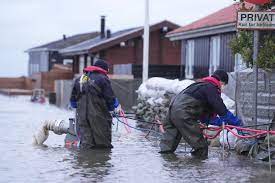
Gale-force winds and floods struck several countries in Northern Europe as the region endured more heavy rain on Friday that forecasters say will continue into the weekend. Three deaths in the U.K. were blamed on the bad weather.
The winds are expected to hit hardest in the eastern part of Denmark’s Jutland peninsula and the Danish islands in the Baltic Sea. But the northern part of the British Isles, southern Sweden and Norway, and northern Germany are also in the path of the storm, named Babet by U.K.’s weather forecaster, the Met Office.
Eastern Scotland continued to bear the brunt of the stormy weather. On Friday, the Met Office issued a new “red” warning, its highest, for parts of the region through Saturday.
“This is not usual autumn weather,” said Andy Page, the Met’s chief meteorologist. “This is an exceptional event, and we are likely to continue to see significant impacts with the potential for further flooding and damage to properties,” said Andy Page, the Met’s chief meteorologist.
On Friday, police reported that a man in his 60s died after getting caught in fast-flowing flood water in the central England county of Shropshire.
Though forecasters said the worst of the heavy rain in Scotland had passed, they warned that conditions will remain difficult, with river levels still on the rise and flood defenses breached. Some parts of the town of Brechin are only accessible by boat after its flood defenses were overwhelmed by the heavy rainfall, raising concerns about further loss of life.
“I cannot stress how dangerous conditions are in Brechin in particular,” said Scotland’s first minister, Humza Yousaf.
Wind gusts in excess of 60 mph (100 kph) were likely on Friday. Several major road sections and rail routes were closed in Scotland, while air passengers were facing flight cancellations.
The storm has already brought more than a month’s worth of rain in the worst-affected regions in Scotland and was pummeling many parts of England on Friday.
At Leeds Bradford Airport, a flight arriving from the Greek island of Corfu skidded off the runway while landing in windy conditions. There were no reported injuries and ensuing arrivals were diverted to other airports.
“We are working with the airline, relevant operations teams and emergency authorities to address this situation and remove passengers from the aircraft safely,” a spokesperson for the airport said.
In northeastern England, a lighthouse at the mouth of the River Tyne lost its distinctive red and white dome. Port of Tyne officials said it was not yet safe to assess the damage to the South Shields lighthouse while weather conditions remained dangerous.
The swirling weather system was also hitting other parts of Northern Europe, particularly Denmark. The Danish Meteorological Institute wrote on X, formerly Twitter, that it expects water levels “to exceed the 100-year event in several places.”
Police in southern Denmark — the Danish region expected to be the worst hit — said a number of sections of road in low-lying areas were flooded and some trees had fallen. Police said a dike was breached and urged people to immediately leave Sandersvig Strand on the Jutland peninsula.
Danish meteorologists issued their highest warning for “very dangerous weather” and said levels of some inland waters were expected to rise up to 240 centimeters (nearly eight feet) above normal.
In neighboring Sweden, meteorologists warned of the risk of extensive flooding which may cause limited access on roads and railways along the southern coasts of the Scandinavian country. Water levels were expected to begin dropping again on Saturday morning, Swedish meteorologists said.
A bridge near Norway’s second-largest city was protectively closed, the Bergens Tidende newspaper said. Ferries across the region were canceled and air traffic was hampered, with delays and a few cancellations.
The Swedish Transportation Authority suspended service of several train and bus lines in southern Sweden, because of the weather, prompting Skanetrafiken, the operator of the local transit system, to recommend ”avoiding travel on public transport.”
”Some regional bus routes will be canceled and there is a risk that both regional and replacement buses in service may also be canceled at short notice,” Skanetrafiken said on its website.
In Germany, some streets and squares were flooded in the cities of Flensburg, Kiel and Wismar on the Baltic coast. Fallen trees caused some disruption, including a railway line. Ferry operator Scandlines suspended services on its Roedby-Puttgarden and Gedser-Rostock routes between Denmark and Germany.
On Germany’s North Sea coast, the high winds had the opposite effect to the flooding on the Baltic coast, pushing the water further out and leading to very low water levels. Ferries to some North Sea islands were canceled.
___
Pylas reported from London. Associated Press writer Geir Moulson in Berlin contributed to this report.







